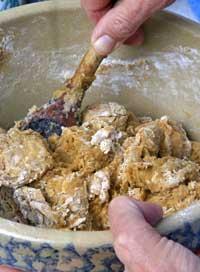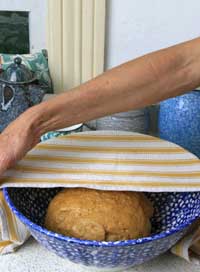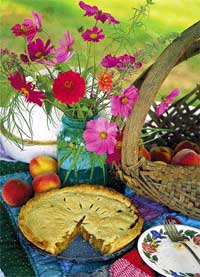By Cherie Langlois / photos by Jean M. Fogle
In the final rising, glazing and slashing stage (shown here), your bread is ready for the oven. In this article More Recipes Get a and more bread and baked good recipes. Click to continue>> |
In my quest to de-stress from life’s inevitable anxieties, I’ve dabbled in various relaxation techniques, from meditation to yoga. I sniff lavender, try to avoid overdosing on caffeine and stroke my purring cats each day.
I unwind by taking long country walks with my dogs and work out my aggressions by attacking weeds in the garden.
But on sullen winter days, when the garden slumbers under mulch and the rain dampens my motivation to exercise outdoors and only multiple cups of coffee stand between me and hibernation, it’s cozy, creative, repetitive activities that soothe me like nothing else.
Maybe I’ll rug hook as the wood stove casts its flickering glow or knit a scarf while listening to the sweet strains of holiday music.
Or perhaps I’ll warm up the day with one of my favorite wintertime activities: making bread the old-fashioned way, by hand.
For me, nearly every part of this sensuous process serves as a cheap form of relaxation therapy:
- Mixing the simple ingredients together;
- Kneading and pummeling the dough until it becomes smooth and pliable;
- Watching the yeast work magic on a lump of flour and water;
- Inhaling the heady perfume of baking loaves;
- and then, at long last, biting into a crusty, light, warm slice of bread—the ultimate, and probably the original, comfort food.
I’m suddenly transported to Paris, savoring fresh bread in a boulangerie without a care in the world.
After you sprinkle dry yeast over warm water, leave it for 5 to 10 minutes; you’ll know the yeast cells are alive when the mixture begins to bubble and froth. Top |
I know. You’re a busy person encumbered with too many responsibilities: a job, a farm, kids, pets, a ringing cell phone and e-mails to answer. You don’t have time to waste baking bread, especially when you can snatch a factory loaf at the store.
Sounds to me like you could use some bread-based therapy, too.
Top
Basic Bread Ingredients
Our world is full of a staggering and mouth-watering variety of breads, thanks to the Earth’s wonderful diversity of cultures.
- Mexico flaunts its tortillas and
- Britain bakes up English muffins;
- Turkey brought us air-filled pitas and
- Greece, egg-topped tsoureki.
- Olive oil-drizzled focaccias from Italy,
- flaky croissants out of France,
- tender Indian naan
The list stretches longer than a baguette.
After you stir in the flour a half cup at a time, keep stirring untl the mix becomes doughy and pulls aways from the side of the bowl. Top |
To produce their distinct flavors and textures, the myriad breads of the world incorporate many different ingredients, including butter, honey, raisins and nuts.
However, all breads that use yeast as a leavening or rising agent share a foundation of four, down-to-earth ingredients (check the lengthier list on store-bought, bagged bread and see if you can even identify every component).
Top
Flour
Flour, created by milling cereal grains (usually wheat) through a succession of grinders, forms the bulk of a bread recipe. In the realm of bread-baking, though, not all grains and flours are created equal.
Wheat, first cultivated some 10,000 years ago in Asia, contains higher concentrations of a protein known as gluten than grains like rye, corn and barley.
Gluten gives dough its elasticity, allowing it to trap gasses released by the yeast and create a light, springy loaf.
To knead, press the heels of your hands firmly into the dough, push down and away from you, fold the dough over itself, turn slightly and repeat. Top |
Bread made solely from low-gluten grains won’t rise well, if at all. Gluten content also varies according to wheat type and the area where the wheat grew.
Different wheat flours will affect the nature of your bread, too. Regular, all-purpose, white flour has had most of the nutritious bran and wheat germ removed. It’s been bleached with chlorine gas to give it a bright-white color, while more eco-friendly, unbleached all-purpose flour has a creamier cast and—I think—a better taste.
According to Maggie Glezer’s in-depth bread book, Artisan Baking (Artisan, 2003), all-purpose flours contain about 10.5 percent protein. Bread flours, on the other hand, have around 12.5 percent protein, which translates to a higher gluten content and more elastic bread dough.
Unlike white flour, whole-wheat flour retains all parts of the wheat kernel, including the healthy bran and wheat germ; however, its protein/gluten content can vary.
This light-brown flour imparts a hearty taste and rustic look to bread, but using it as the only flour will make for a stickier dough and denser loaf, so many recipes call for combining it with unbleached white flour.
Set dough ball into an oiled bowl and cover with a damp towel. Top |
Finally, if you prefer that your bread come from sustainable sources, look for organic flours milled from wheat grown without conventional synthetic fertilizers, pesticides or genetically modified seeds.
Top
Salt
While it’s possible to concoct bread without salt, adding a little salt to the flour has several important functions: It enhances flavor, controls the yeast’s action so the dough rises evenly, and helps postpone that inevitable time when the bread turns hard and stale.
Yeast
Yeasts are miniscule, one-celled fungi that live all around and within us: on plant surfaces, on our skin, inside our intestines and in salt water.
Wild yeasts, of which many species and strains exist, also float in the air; in fact, a warm mixture of flour and water left to sit for several hours will begin fermenting, thanks to the floating yeast it snares (this is one way to create
sourdough-type breads).
After the first rising, punch the down down with your first and give a quick kneading. Top |
Thousands of years ago, humankind may have accidentally discovered yeast’s leavening super-powers in this way.
Introduce yeast into warm water and then to flour, and this living organism immediately starts fermenting the sugars present in the dough (some recipes call for added sugar to “feed” the yeast).
Fermentation produces ethanol along with carbon dioxide gas, and the gases create tiny bubbles that become trapped in the dough’s stretchy gluten, making it expand in size, or rise. Without yeast—or another leavening agent, like baking soda—the resulting bread would turn out as flat as a tortilla.
The fermentation begun by the yeast imparts the loaf with a spongy texture, delicious aroma and real-bread taste. Most home bread bakers use commercially made, regular, dry yeast available from grocery stores in small packets or more economical bulk amounts at health-food markets and warehouse stores, like Costco.
Top
Water
The addition of water to flour causes the gluten to form, creating a protein network to capture carbon dioxide produced by the yeast.
Voila, a dry mix of flour and salt becomes dough. Any safe drinking water will do.
How to Make Bread
Many people seem to think making bread from scratch is a difficult, complicated affair that requires either hours of hard work or an expensive bread machine to get the job done.
Beginner’s Bread This easy recipe makes two small, tasty loaves while introducing you to the joys of baking bread. Try it once, and then feel free to experiment with different flours (such as substituting whole wheat for half of the bread flour), herb toppings, and texture- or flavor-improving additives like honey and milk.
Yield: 2 loaves Ingredients
- 1 1⁄2 cups warm water
- 3 tsp. dry yeast
- 1 tsp. salt
- About 3 to 4 cups unbleached bread flour
- 1 egg
- 1 tsp. water
Preparation
Pour the warm water into a large mixing bowl and sprinkle with yeast. Set aside to proof for 5 to 10 minutes. Whisk the yeast/water mixture and add salt. Stir in the first two cups of bread flour 1/2 cup at a time. Continue adding flour until a dough forms and it becomes too difficult to stir. Place dough on a lightly floured cutting board and knead in more flour until it loses its stickiness. Knead for about 10 minutes until smooth and elastic. Place dough in an oiled bowl and turn to coat, cover with a damp towel, and let rise in a warm, draft-free area for about one hour or until doubled in size. Punch down the dough, knead for several minutes, divide and shape into logs to fit two oiled or buttered rectangular bread pans (9” x 5” x 3”). Cover with a damp towel and let rise for another 30 minutes or until doubled in size. Preheat oven to 400 degrees F. In a small bowl, whisk together the egg and water. Brush just the top of the loaf with glaze. Place pans on the center rack of heated oven and bake for approximately 30 minutes, until the crust looks golden and the loaf sounds hollow when tapped on the bottom. Remove loaves from pan and set on wire rack to cool. Bon appetit! Top |
Not so. If the pioneers with their bare-bones kitchen utensils, wood stoves and dawn-to-dusk work schedules could make bread, so can you. Just follow these basic steps.
Top
Mix the Ingredients
Many recipes, including our Beginner’s Bread recipe, call for sprinkling dry yeast over warm water (about 110 to 115 degrees F) and leaving it for five or 10 minutes to ensure it’s still active, a process known as “proofing.”
You’ll know the yeast cells are still alive and kicking when the mixture begins to bubble and froth.
If it doesn’t, the yeast may be past its expiration date—in a word, dead.
You’ll also find recipes that instruct cooks to add yeast directly to the dry ingredients, then mix in water of a slightly warmer temperature (around 120 to 130 degrees F).
Still others use the “sponge” method which involves mixing up a batter of water, yeast and flour first. Whatever technique you use, be careful not to kill your yeast by overheating it.
After the yeast proofs, whisk the mixture and add the salt. Then stir in the flour about 1/2 cup at a time until the mixture becomes doughy and pulls away from the side of the bowl, becoming too difficult to stir.
Knead the Dough
Next to devouring bread fresh from the oven, kneading dough is the part of bread-baking I enjoy the most.
For some years, I used a standing mixer for kneading, and for people with arthritis, carpal tunnel or other issues making it difficult to knead dough, this makes a great tool.
Then along came my daughter, and the search for entertaining activities we could share together began. Not only did I have as much fun playing with dough as she did, but I loved the soothing motions, the quiet and the workout it gave my hands and arms. I never went back to my mixer.
Top
Bread dough needs plenty of kneading to stretch and warm the gluten.
Again, stretchy gluten strands help capture carbon dioxide produced by fermentation, making the dough rise and yielding an airy loaf with a moist, sponge-like crumb. Too little kneading can result in a flat, dense, chewy bread loaf.
To begin:
- Deposit the dough onto a lightly floured bread board or another clean surface
- Knead in more flour until the dough loses its sticky feel
- Press the heels of your hands firmly into the dough (don’t be wimpy!)
- Push it down and away from you
- Fold the dough over on itself, turn it slightly and repeat
I like to give the dough a punch once and awhile for good measure. Keep kneading until the dough feels smooth and elastic, about 10 minutes (or as specified in the recipe).
Let It Rise
Set your fragrant dough ball into an oiled bowl and cover with a damp towel to keep a dry crust from forming on top.
Find a draft-free spot to place the bowl so the yeast can make the dough rise. A temperature of 75 to 85 degrees F works well for most breads; cooler temperatures won’t hurt the yeast, but will slow the rising process.
During winter, I turn the oven onto its lowest setting for about 15 minutes, switch it off and put the dough inside to rise with the door ajar (remember not to prematurely cook your yeast!).
Depending on room temperature, the rising time will run one to two hours, leaving you free to do other chores.
Allow the rising dough to double in size, but no more—letting it balloon out of control can cause the poor yeast to suffocate.
Top
Punch and Shape
After the first rising, punch the dough down with your fist and give it a quick kneading to redistribute gasses formed during fermentation.
Now the dough is ready to shape.
Visit a European bakery or pour over a beautifully photographed book like Bread: The Breads of the World and How to Bake Them at Home by Christine Ingram and Jennie Shapter (Hermes House, 2003), and you’ll encounter a delightful variety of bread shapes, from simple round boules to braided challahs.
For starters, try fashioning an easy rectangular loaf by molding or rolling your dough into a log-like shape to fit the size of your pan. Place the dough in the greased pan with any seams on the bottom.
Top
Rise Again, Glaze and Slash
Cover your loaves with a moist towel and allow the dough to rise again for 30 minutes to an hour until no more than doubled in bulk. Before you bake, bread recipes often suggest brushing on a glaze of some kind, such as egg white, yolk or milk, to give the loaf a shiny, golden crust and seal in moisture.
Slashing or cutting the loaf with a sharp knife lends a rustic touch and also helps the bread retain its shape during baking.
Bake, Cool and Eat!
Preheat your oven to the recommended temperature and when it’s hot and ready, carefully slip your pans onto a center rack.
Start out cooking your loaves for the amount of time suggested by the recipe, but keep in mind these times may vary.
Spritzing some water inside the oven once or twice while the bread cooks can help mimic the steamier conditions found in professional bakers’ ovens.
To test for doneness in the time-honored manner, remove the loaf from its pan with oven mitts and tap the bottom with your finger. If the loaf sounds hollow, it’s done. Remove your bread to a rack to cool, but don’t forget to sample a slice while it’s still warm (not a problem for my family!).
Top
Bread-making is a skill that anyone can learn, but it does take practice and patience.
Resist feeling too disappointed if, after following a specific recipe to the letter, your bread looks different from the perfect loaf pictured in the cookbook.
Baking bread is an imprecise science, with many variables affecting the outcome and plenty of room for error. For example, while baking today, my daughter and I accidentally dripped egg glaze between the dough and pan; as it cooked, the glaze glued the bread to the pan.
While we managed to pry one loaf out intact, the other stuck fast and came out minus the bottom crust. But you know what? It still tasted divine.
So put on your favorite music, relax into the moment and savor every part of the bread-making experience—even your mistakes. They’ll teach you to be a better baker and, best of all, they’re edible.
About the Author Cherie Langlois is a hobby farmer and freelance writer whose bread-baking habit helps her
survive winter in western Washington. She wishes to thank daughter Kelsey and French exchange student Clemence for their expert assistance in testing—and eating—the bread recipes.
Top



















